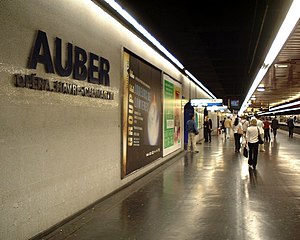Auber (Paris RER)
| RER station | ||||||||||||||||||||||||||||||||||||||||||||||||||||||||||||||||||
 |
||||||||||||||||||||||||||||||||||||||||||||||||||||||||||||||||||
| Owned by | RATP | |||||||||||||||||||||||||||||||||||||||||||||||||||||||||||||||||
| Line(s) | ||||||||||||||||||||||||||||||||||||||||||||||||||||||||||||||||||
| Platforms | 2 side platforms | |||||||||||||||||||||||||||||||||||||||||||||||||||||||||||||||||
| Tracks | 2 | |||||||||||||||||||||||||||||||||||||||||||||||||||||||||||||||||
| Construction | ||||||||||||||||||||||||||||||||||||||||||||||||||||||||||||||||||
| Disabled access | Yes | |||||||||||||||||||||||||||||||||||||||||||||||||||||||||||||||||
| Other information | ||||||||||||||||||||||||||||||||||||||||||||||||||||||||||||||||||
| Fare zone | 1 | |||||||||||||||||||||||||||||||||||||||||||||||||||||||||||||||||
| History | ||||||||||||||||||||||||||||||||||||||||||||||||||||||||||||||||||
| Opened | 23 November 1971 | |||||||||||||||||||||||||||||||||||||||||||||||||||||||||||||||||
| Services | ||||||||||||||||||||||||||||||||||||||||||||||||||||||||||||||||||
|
||||||||||||||||||||||||||||||||||||||||||||||||||||||||||||||||||
Auber (French pronunciation: [obɛːʁ]) is a station on Line A of the RER in Paris, France. Opened on 23 November 1971 it was at the time the largest underground station in the world, and represents a feat of underground engineering.
The station comprises a main train hall with a superposed ticket hall, together with an extensive network of particularly spacious tunnels connecting to the neighbouring métro stations Opéra, Havre-Caumartin and Saint-Lazare, as well as Haussmann - Saint-Lazare on the RER Line E.
It takes its name from the , under which it is situated. This street is in turn named after the 19th-century composer Daniel-François-Esprit Auber.
Auber is built in the style of the traditional vaulted métro station as pioneered by Fulgence Bienvenüe, with central tracks and lateral platforms. The difference in engineering terms is that Auber (along with Charles de Gaulle - Étoile and Nation stations) was constructed at depth, entirely underground, and on a far larger scale than any métro station.
In order to build the 225‑m-long, 24‑m-wide train hall and its even more immense piggy-backing ticket hall, it was necessary to excavate a cavity 40 m wide, 20 m high and 250 m long—and this 30 m underneath the busy city centre in unstable waterlogged sedimentary rock. The resulting station is cathedral-like in proportions, with a ticket hall so spacious that there is room for a mezzanine. The entire construction is waterproofed on both sides by a 7‑m-thick, 10‑m-high abutment of concrete which contains escalators linking the two levels.
...
Wikipedia
